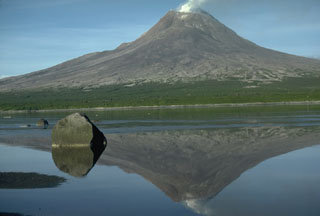Report on Augustine (United States) — August 1976
Natural Science Event Bulletin, vol. 1, no. 11 (August 1976)
Managing Editor: David Squires.
Augustine (United States) Degassing of ash-flow deposits and summit lava dome
Please cite this report as:
Global Volcanism Program, 1976. Report on Augustine (United States) (Squires, D., ed.). Natural Science Event Bulletin, 1:11. Smithsonian Institution. https://doi.org/10.5479/si.GVP.NSEB197608-313010
Augustine
United States
59.3626°N, 153.435°W; summit elev. 1218 m
All times are local (unless otherwise noted)
The Augustine investigation team reports that: "Degassing of ash-flow deposits an the new summit lava dome continued during July and August. There were only a few local seismic events and no new eruptive activity.
"Field work during mid-August disclosed that the initial January 1976 eruptions had been the most explosive and extensive of three cycles that occurred in late January, mid-February, and mid-April. Pyroclastic flows of the January cycle extended in all directions away from the summit, reaching the sea on the S and NE sides of the volcano. One of the hot pyroclastic clouds overran Burr Point Research Station, at the northernmost tip of the island 5 km from the summit, damaging it severely. The velocity of the cloud was high enough to dent the aluminum structures. Thermal and blast effects on the structures indicate that they were hit from the side facing away from the volcano. We infer that the structures must have been damaged by a back eddy of the turbulent pyroclastic cloud that continued out to sea.
"The decreasing explosivity of eruptions and extent of deposits during the February and April activity reflects a change in the mechanism of eruption, from pyroclastic explosions of January and 6 February, to block and ash flows avalanching off the newly emerging viscous andesitic lava dome in the crater during the latter part of February and April. Emplacement of the lava dome has now nearly obscured the January crater, but has not yet restored the summit to its pre-1976 elevation.
"Gas samples have been collected from active fumaroles at the margin and on the flanks of the new lava dome. Temperatures up to 457°C were measured in these fumaroles. A maximum of 430°C was measured in fumaroles emitted from the February ash flow deposits, as compared to maximum fumarole temperatures of 603°C measured soon after their emplacement. Fumarolic emission from the January deposits has ceased entirely.
"On the basis of the recent work and comparison to the past eruptive history of Augustine, we now believe that the explosive phase of the 1976 eruptive cycle is over and that activity in the near future is likely to be limited to local debris fall and mudflows."
Further Reference. Kienle, J., and Shaw, G.E., 1979, Plume dynamics, thermal energy and long-distance transport of Vulcanian eruption clouds from Augustine volcano, Alaska: JVGR, v. 5, p. 139-164.
Geological Summary. Augustine volcano, rising above Kamishak Bay in the southern Cook Inlet about 290 km SW of Anchorage, is the most active volcano of the eastern Aleutian arc. It consists of a complex of overlapping summit lava domes surrounded by an apron of volcaniclastic debris that descends to the sea on all sides. Few lava flows are exposed; the flanks consist mainly of debris-avalanche and pyroclastic-flow deposits formed by repeated collapse and regrowth of the summit. The latest episode of edifice collapse occurred during Augustine's large 1883 eruption; subsequent dome growth has restored the edifice to a height comparable to that prior to 1883. The oldest dated volcanic rocks on Augustine are more than 40,000 years old. At least 11 large debris avalanches have reached the sea during the past 1,800-2,000 years, and five major pumiceous tephras have been erupted during this interval. Recorded eruptions have typically consisted of explosive activity with emplacement of pumiceous pyroclastic-flow deposits followed by lava dome extrusion with associated block-and-ash flows.
Information Contacts: Augustine Field Party, Geophysical Institute, University of Alaska, and Univ. of Washington; D. Johnston, H.-U. Schmincke, J. Kienle, and M. Utting, Univ. of Alaska.

